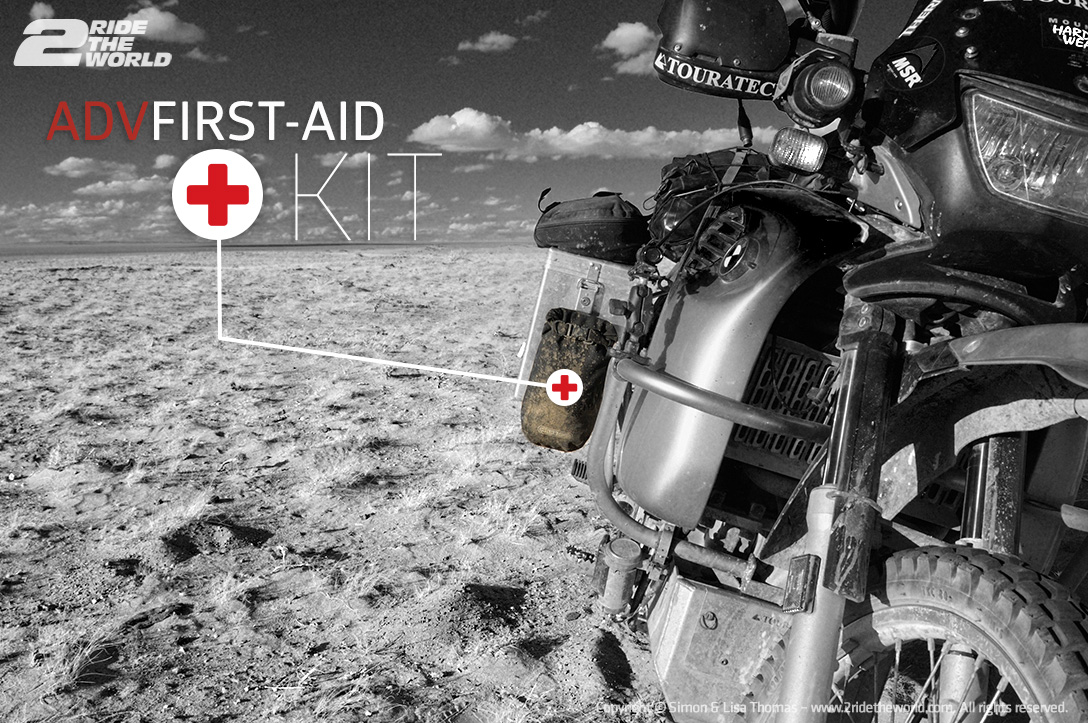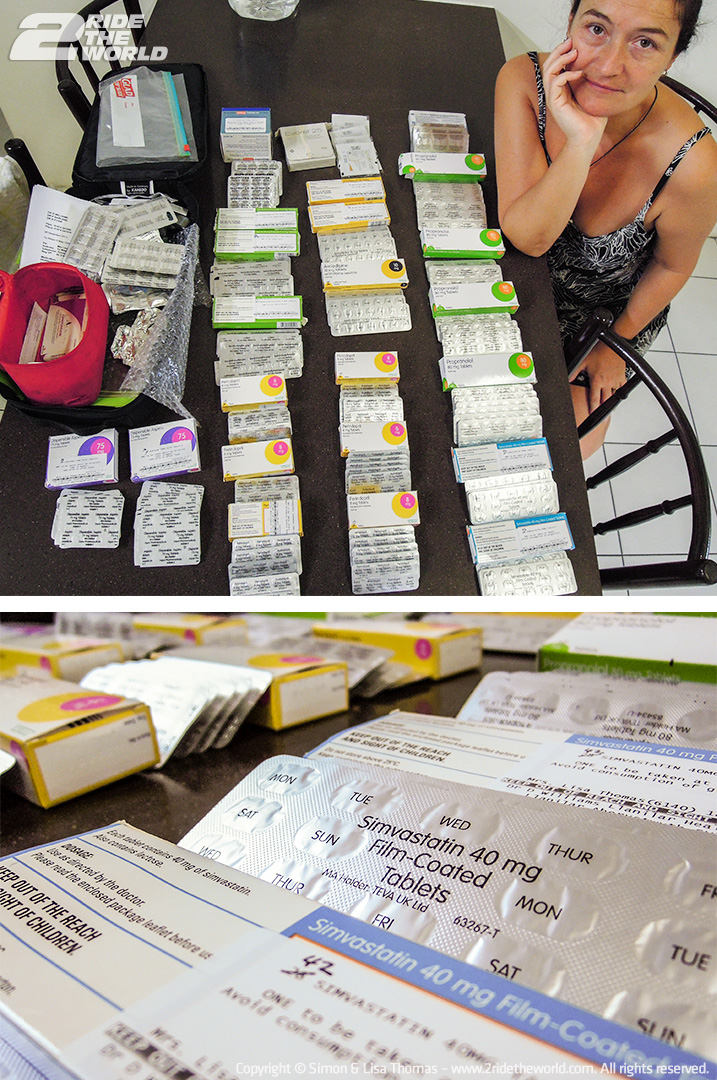ADV Medi Kit
Simon and I carry an Adventure Motorcycling First Aid Kit that we know will cover us for a variety of minor and more serious injuries and ailments. Unfortunately we have had to use it during our time on the road.
‘Normal’ travel can lay you open to all sorts of infections from contaminated food or water, from insect bites, animal bites, from other people, the list is endless. Riding a motorcycle can add a whole new list of potential problems! Burns, grazes, cuts, broken limbs...I wont go on as this list is not intended to put you off (or your loved ones if they are reading this too!) but vaccinations, medications, and simple precautions can reduce or eliminate many of the risks.
 Jabs
Jabs
Prior to leaving Simon and I had to suffer 28 separate vaccinations ranging from Hepatitis A, Hepatitis B, Japanese Encephalitis, Encephalitis, Rabies, Yellow fever to name but a few!
Many African countries have actual entry requirements and won’t let you in unless you have proof you’ve been vaccinated against a specific disease. The most common is yellow fever.
So, where can you find all of this important information? How do you know which vaccination is required for which country? Where are the malarial zones? Have there been recent ‘outbreaks’ of diseases in the country (countries) that you will be traveling to?
For the most up to date information on individual countries and ‘easy to use’ website I like to use: www.fitfortravel.nhs.uk But there are many similar websites out there, just make sure you do at least use one of them!
Be responsible
know the correct usage of medications and medical kit you carry with you. Get advice from your Doctor prior to leaving on how to use and take medications correctly. Be aware that you may suffer adverse reactions to certain medications and tablets. Be aware of Adverse interactions between your prescription medications and other drugs or herbal remedies.
Basically before you head out do your homework and make sure you know how any medication you carry might affect you! Luckily for Simon I was already qualified under an internationally recognized course for First Aid Training prior to heading out on this journey.
 Carrying your prescribed medications
Carrying your prescribed medications
![]() You must take your doctors prescription for all of the prescribed medications you are carrying.
You must take your doctors prescription for all of the prescribed medications you are carrying.
- Take the medications in their original containers, bearing the name of the pharmacy and the prescribing physician: This is very important for customs.
- Pack the medications in a clear plastic bag with a prescription written by your doctor.
- Make sure you pack your pills well as many will turn to dust after the vibrations of a long off-road section. Either keep them in their sealed blister packs tightly packed together or if they are in a pill bottle, fill it to the top with cotton wool or a small piece of foam; nothing must have the chance to move!
- Pack them somewhere you know will remain absolutely dry whatever the weather, or plastic bag them and also seal with good old duct tape!
- Take a list of the generic drug names of your prescribed medications.
- The advice on most of my prescribed medications is: ‘do not store in temperatures above 25°C’. This is, of course, a problem when you are travelling in certain parts of the world in extreme temperatures.
What We Carry - Medical Kit list:
We carry the Ortleib medical kit DIN 13167 which includes the following:
- Emergency bandage
- Surgical gloves x4
- Adhesive plasters
- 2 compression bandages
- 1 rescue sheet
- 1 dressing
- 1 pair of scissors
 Wound Closure Kit
Wound Closure Kit
- Irrigation syringe
- Iodine solutions
- Tincture of Benzoin (2)
- Antiseptic wipes (6)
- 2 sterile dressings (4)
- Anti-biotic ointment
- Wound closure strips: 1/4” x4” (10)
Trauma Wound Dressing. (Hemorrhage Compression bandage)
- Non-stick pad.
- Pressure application.
- Secondary sterile dressing.
- Closure bar.
Additional Items
- Steri-strips – stitchless wound closure for small wounds.
- Syringe and needle pack. Various needles.
- Variety of adhesive dressings, all sizes.
- Rescue blanket: For hypothermia and shock.
- Micropore medical tape.
- Mepore: adhesive surgical dressings variety of sizes.
- Burn gel 10 packs of 3.5g
- Wound cleansing wipes. 10 sachets.
- Carmellose sodium Eye drop solution. 30 single use containers.
- Sterilized tweezers.
- Eye bath.
- Tick remover. We use a small tick remover tool to ensure we remove the entire tick properly.
- Thermometer.
- EpiPen – Auto-Injectors for the emergency treatment of life-threatening allergic reactions (anaphylaxis)
- Doxycycline 100mg daily. This is a Malaria prophylaxis. Malaria is a serious and sometimes-fatal disease transmitted by mosquitoes. There is no vaccination against malaria. Ensure that you read up about how to use doxycycline properly, the interactions with other drugs and potential side effects.
- Ciprofloxacin. Effective against a large number of bacteria. I have used it for urinary tract infections, and travelers’ diarrhea.
- Augmentin. Used for certain types of bacterial infections.
- Metronidazole – prescription is needed: used to treat a variety of infections.
- Savlon: General antiseptic solution
- Canestin cream. Antifungal cream used for vaginal thrush. Ladies make sure you have some with you!
- Anti bacterial hand gel.
- Gaviscon tablets for heartburn.
- Rehydration sachets (6)
- Immodium
- Paracetamol tablets
- Ibuprofen tablets
- Antihistamine tables and ointment; used to relieve severe itching. Make sure you use a non-drowsy formula!
- Dulcolax tablets: An emergency treatment for constipation. These are laxatives! Be warned.
- Elastoplast (variety)
- Ibuprofen gel
- Preparation H: Hemorrhoid ointment.
- Athletes foot cream
- Tea tree oil. Good for a variety of skin infections.
- Tiger Balm.
- Mosquito repellant.
- Re-useable hot/cold pack.
- Safety pins.
- Ear buds
And finally an orange cloth to be used as a signaling devise in case of an emergency. This is instantly recognizable as an emergency signal from the air.
This all seems like a massive amount to carry but it packs down really small. I carry it as an attachment (therefore easily and quickly accessible) in a Touratech waterproof pouch bag which latches on directly to the front of our Zega Pro panniers.
https://www.2ridetheworld.com/tips-n-tricks/adv-medi-kit-first-aid-what-to-carry#sigProId82509415b0










